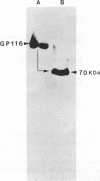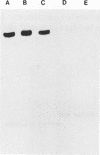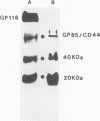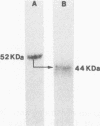Abstract
We used complementary biochemical and immunological techniques to establish that an endothelial cell transmembrane glycoprotein, GP116, is a CD44-like molecule and binds directly both to extracellular matrix components (e.g., hyaluronic acid) and to ankyrin. The specific characteristics of GP116 are as follows: (i) GP116 can be surface labeled with Na 125I and contains a wheat germ agglutinin-binding site(s), indicating that it has an extracellular domain; (ii) GP116 displays immunological cross-reactivity with a panel of CD44 antibodies, shares some peptide similarity with CD44, and has a similar 52-kDa precursor molecule, indicating that it is a CD44-like molecule; (iii) GP116 displays specific hyaluronic acid-binding properties, indicating that it is a hyaluronic acid receptor; (iv) GP116 can be phosphorylated by endogenous protein kinase C activated by 12-O-tetradecanoylphorbol-13-acetate and by exogenously added protein kinase C; and (v) GP116 and a 20-kDa tryptic polypeptide fragment of GP116 from the intracellular domain are capable of binding the membrane-cytoskeleton linker molecule, ankyrin. Furthermore, phosphorylation of GP116 by protein kinase C significantly enhances GP116 binding to ankyrin. Together, these findings strongly suggest that phosphorylation of the transmembrane glycoprotein GP116 (a CD44-like molecule) by protein kinase C is required for effective GP116-ankyrin interaction during endothelial cell adhesion events.
Full text
PDF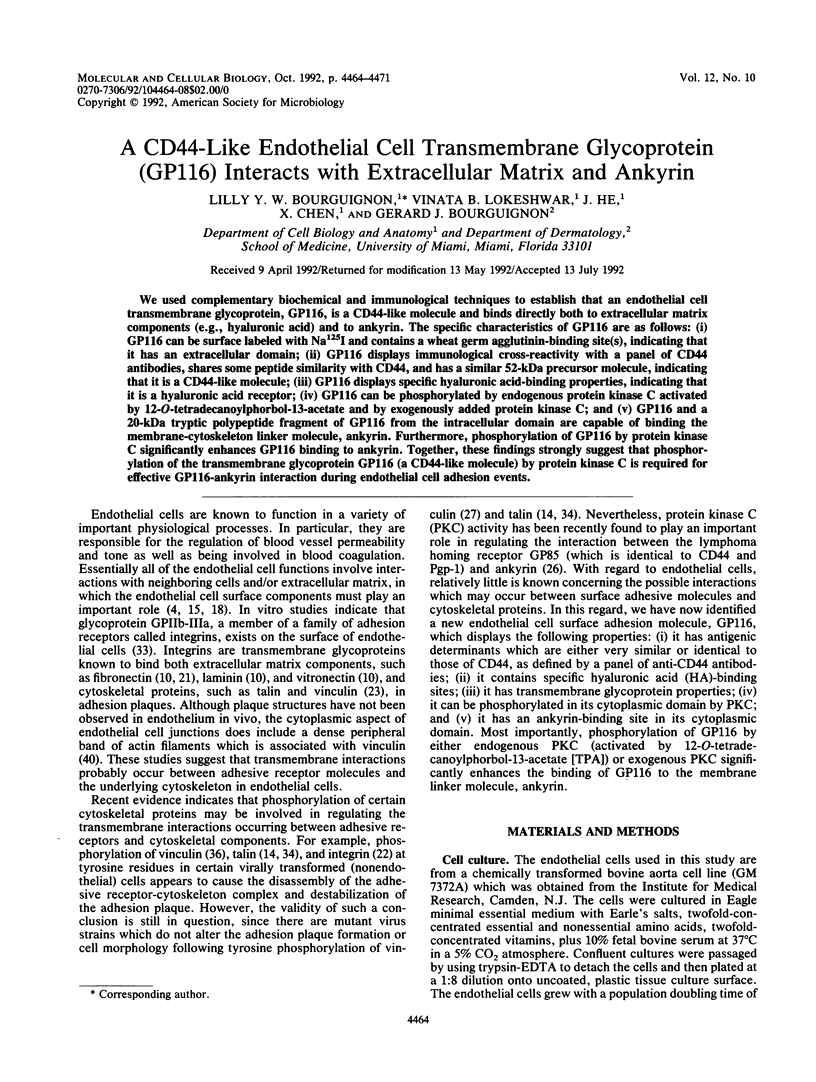
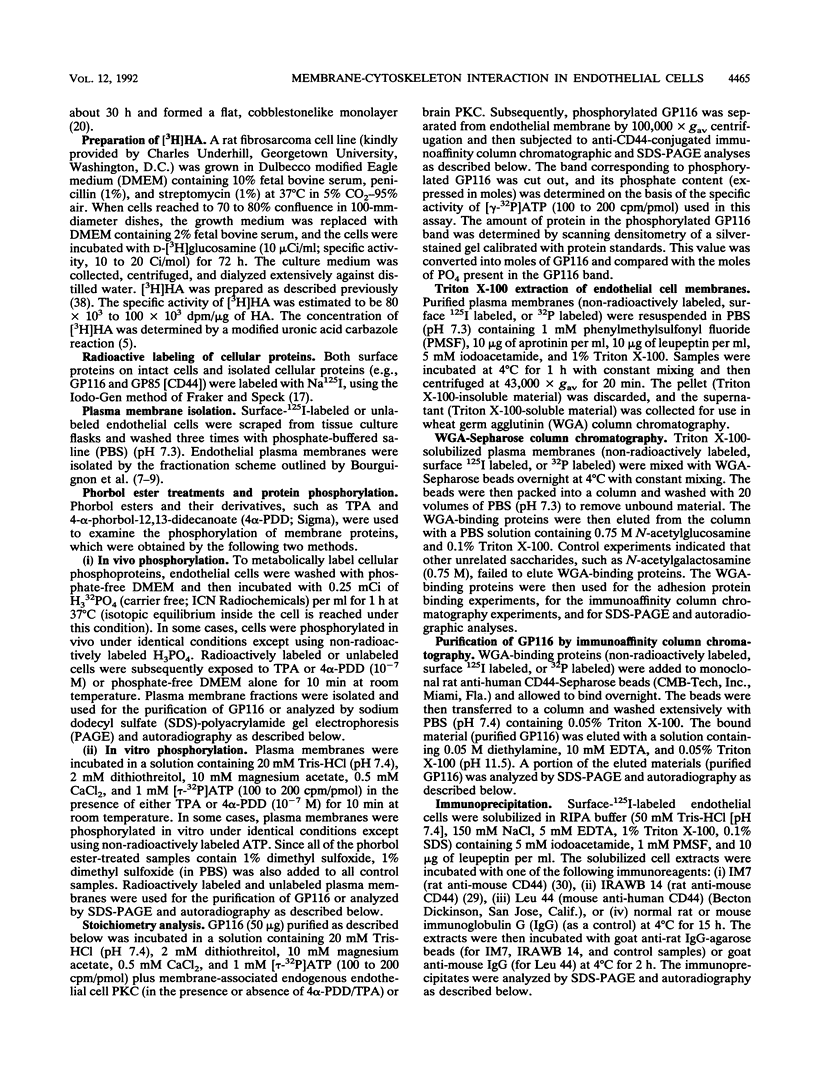
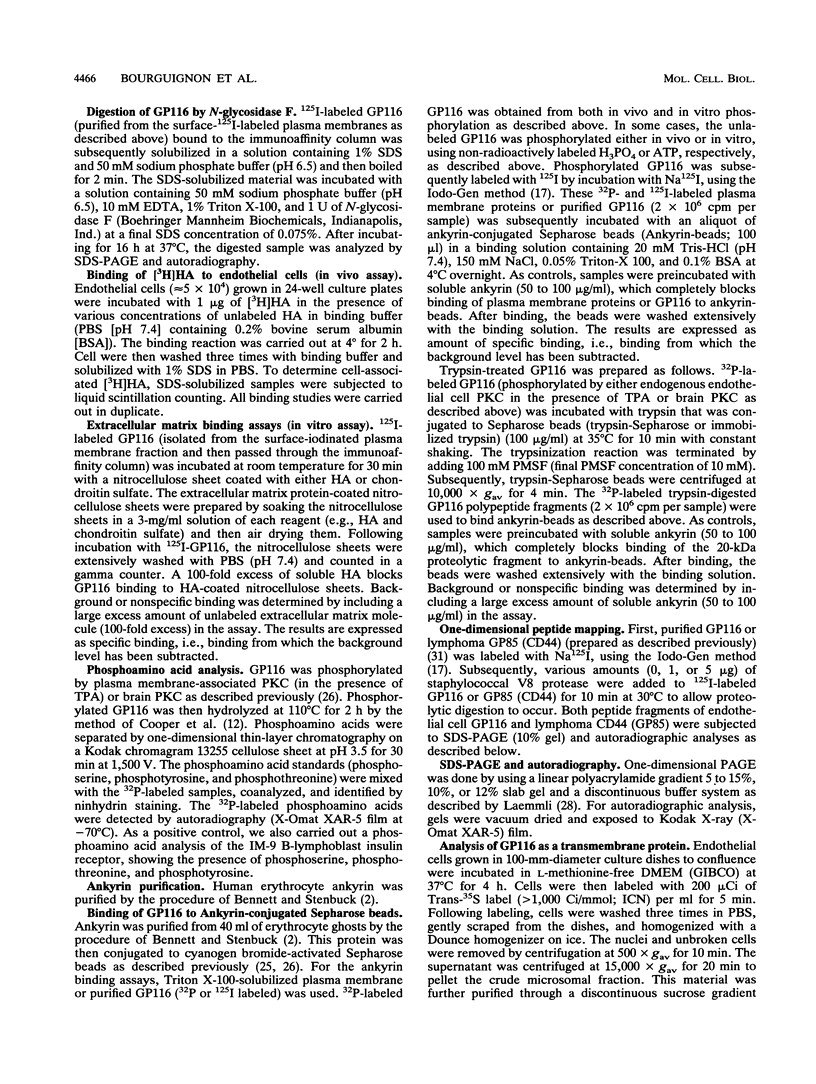
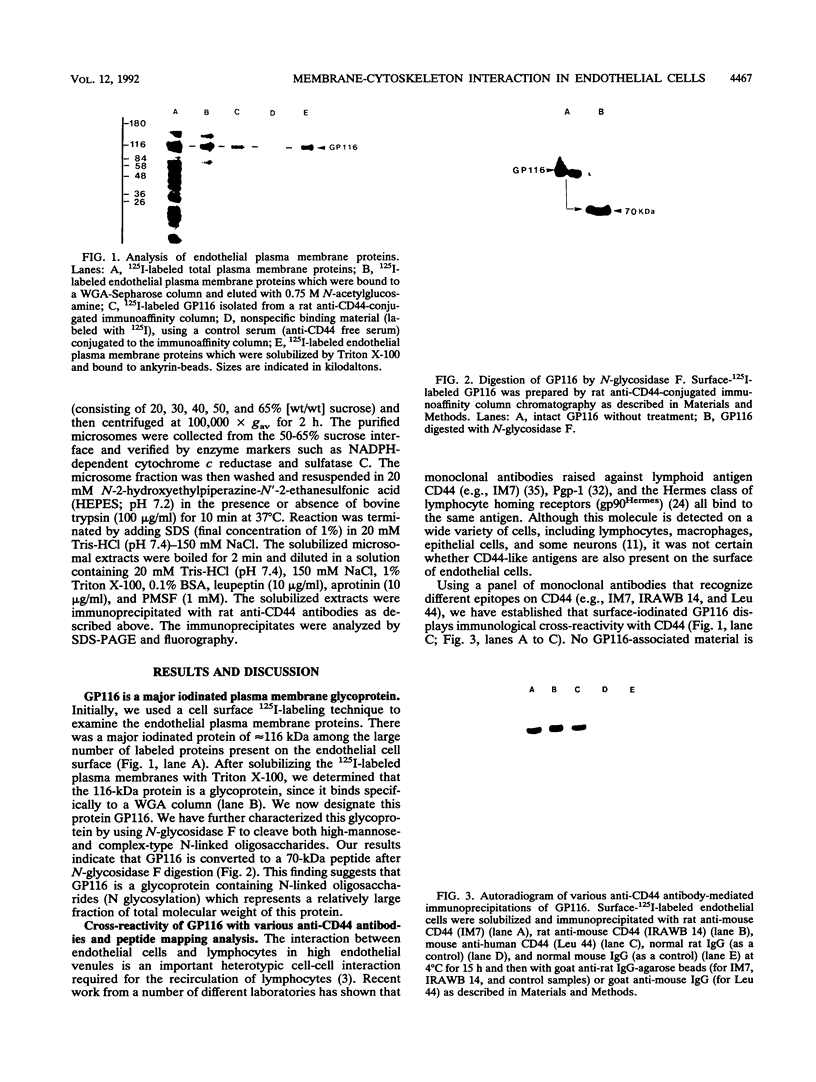
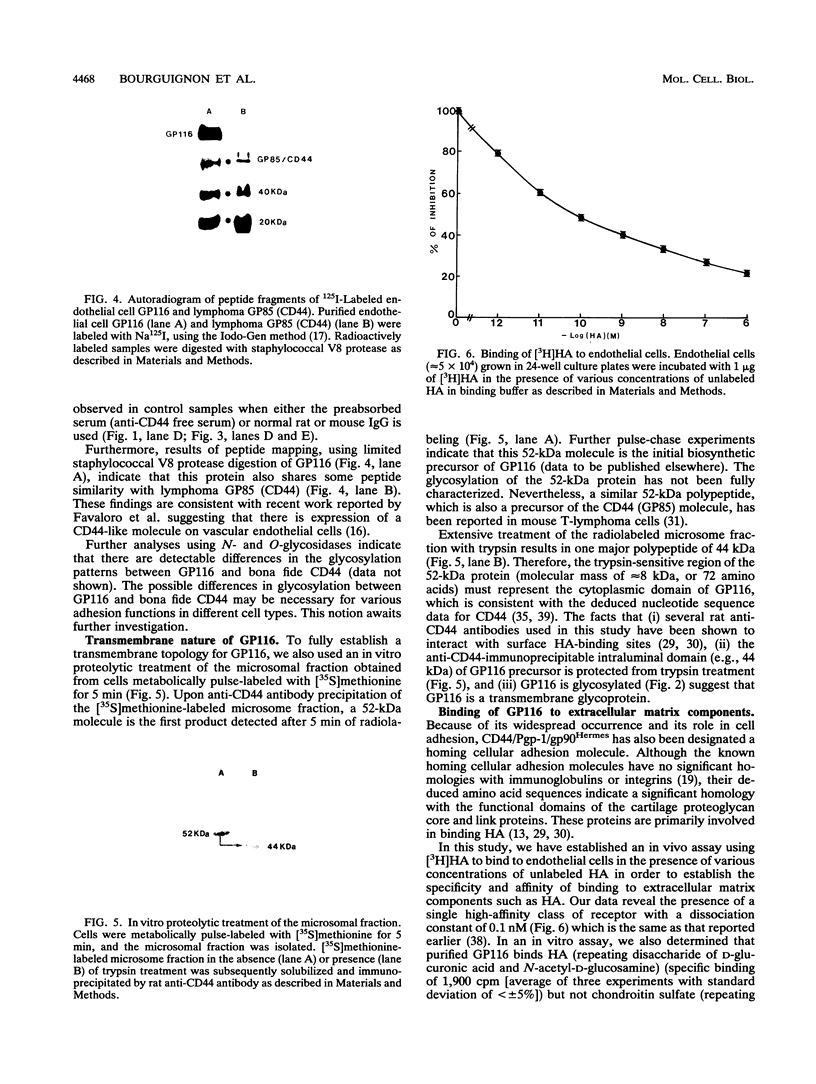
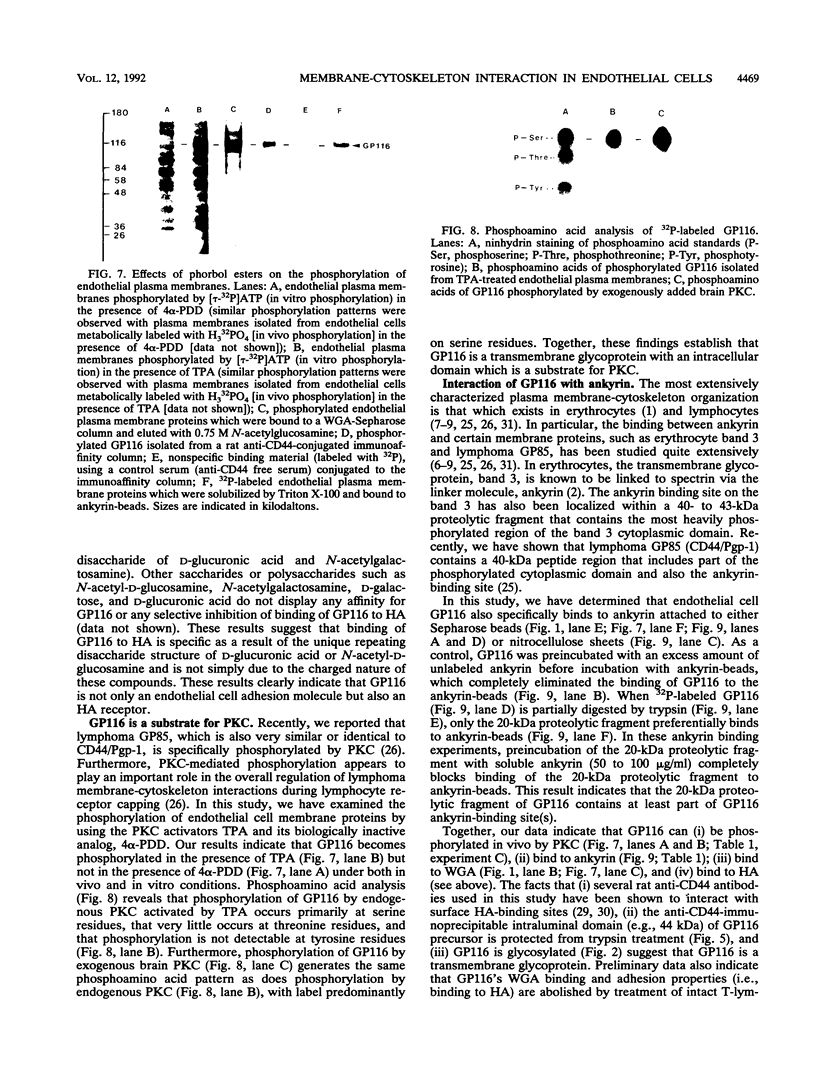
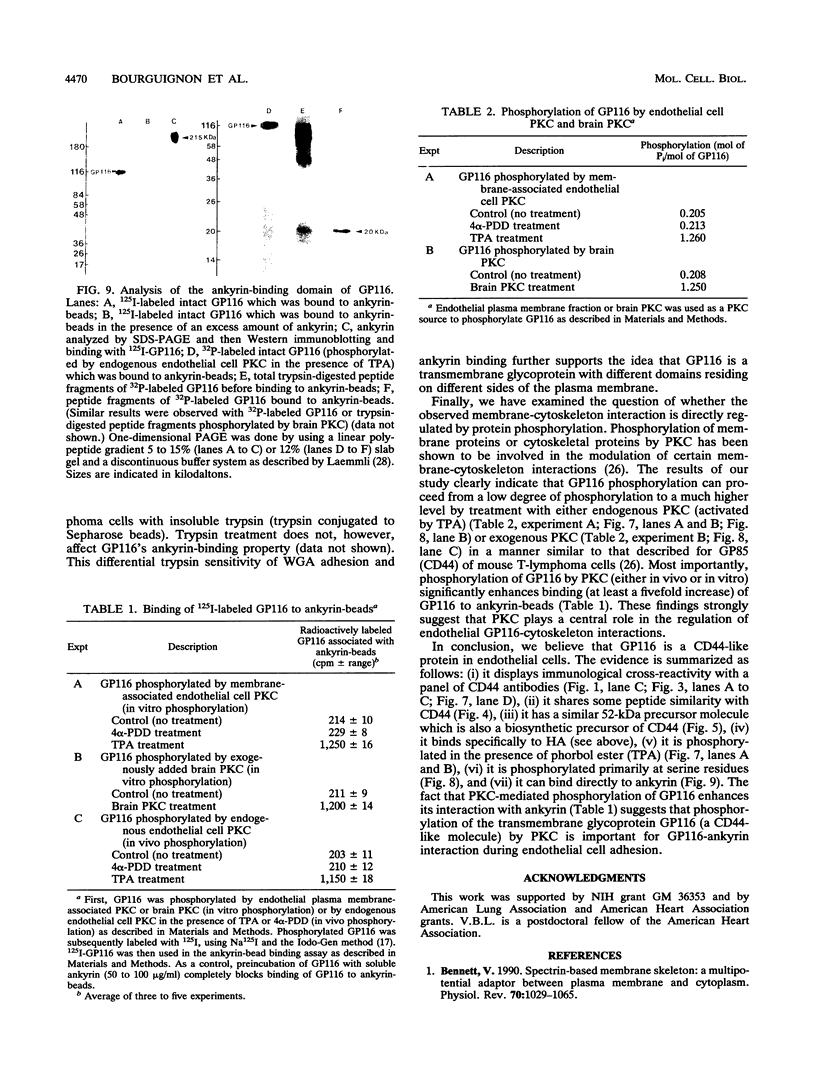
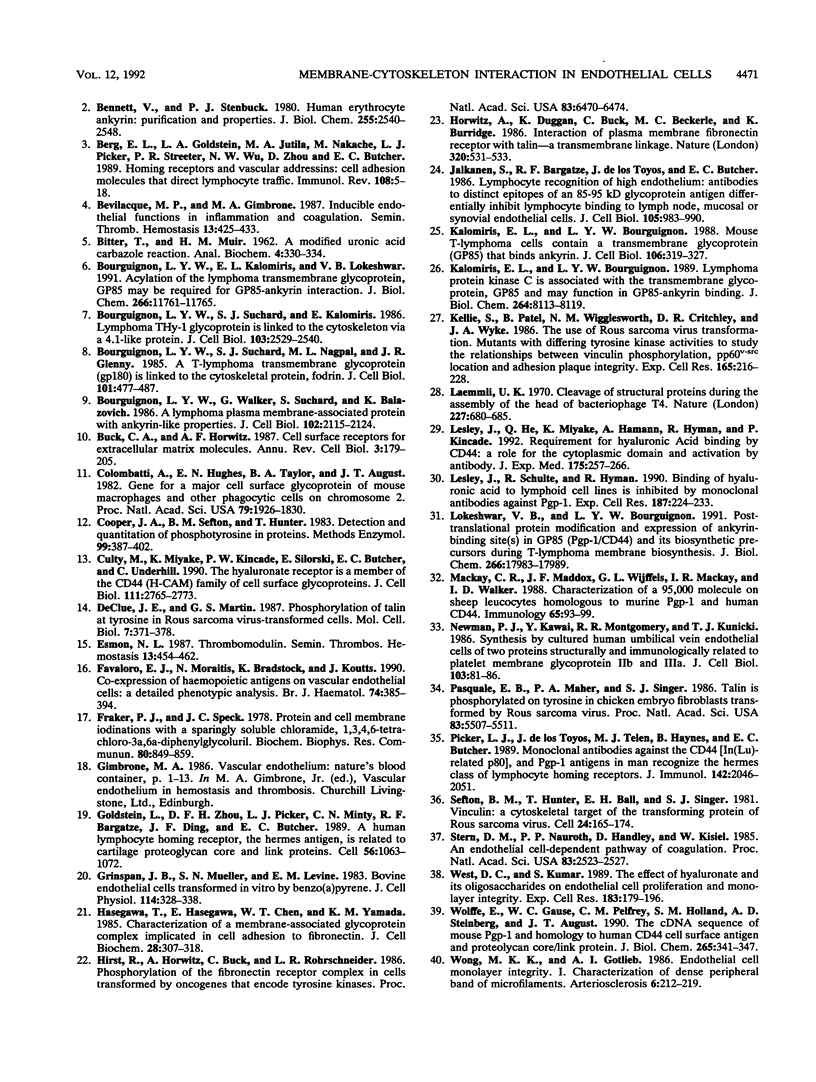
Images in this article
Selected References
These references are in PubMed. This may not be the complete list of references from this article.
- BITTER T., MUIR H. M. A modified uronic acid carbazole reaction. Anal Biochem. 1962 Oct;4:330–334. doi: 10.1016/0003-2697(62)90095-7. [DOI] [PubMed] [Google Scholar]
- Bennett V. Spectrin-based membrane skeleton: a multipotential adaptor between plasma membrane and cytoplasm. Physiol Rev. 1990 Oct;70(4):1029–1065. doi: 10.1152/physrev.1990.70.4.1029. [DOI] [PubMed] [Google Scholar]
- Bennett V., Stenbuck P. J. Human erythrocyte ankyrin. Purification and properties. J Biol Chem. 1980 Mar 25;255(6):2540–2548. [PubMed] [Google Scholar]
- Berg E. L., Goldstein L. A., Jutila M. A., Nakache M., Picker L. J., Streeter P. R., Wu N. W., Zhou D., Butcher E. C. Homing receptors and vascular addressins: cell adhesion molecules that direct lymphocyte traffic. Immunol Rev. 1989 Apr;108:5–18. doi: 10.1111/j.1600-065x.1989.tb00010.x. [DOI] [PubMed] [Google Scholar]
- Bevilacqua M. P., Gimbrone M. A., Jr Inducible endothelial functions in inflammation and coagulation. Semin Thromb Hemost. 1987 Oct;13(4):425–433. doi: 10.1055/s-2007-1003519. [DOI] [PubMed] [Google Scholar]
- Bourguignon L. Y., Kalomiris E. L., Lokeshwar V. B. Acylation of the lymphoma transmembrane glycoprotein, GP85, may be required for GP85-ankyrin interaction. J Biol Chem. 1991 Jun 25;266(18):11761–11765. [PubMed] [Google Scholar]
- Bourguignon L. Y., Suchard S. J., Kalomiris E. L. Lymphoma Thy-1 glycoprotein is linked to the cytoskeleton via a 4.1-like protein. J Cell Biol. 1986 Dec;103(6 Pt 1):2529–2540. doi: 10.1083/jcb.103.6.2529. [DOI] [PMC free article] [PubMed] [Google Scholar]
- Bourguignon L. Y., Suchard S. J., Nagpal M. L., Glenney J. R., Jr A T-lymphoma transmembrane glycoprotein (gp180) is linked to the cytoskeletal protein, fodrin. J Cell Biol. 1985 Aug;101(2):477–487. doi: 10.1083/jcb.101.2.477. [DOI] [PMC free article] [PubMed] [Google Scholar]
- Bourguignon L. Y., Walker G., Suchard S. J., Balazovich K. A lymphoma plasma membrane-associated protein with ankyrin-like properties. J Cell Biol. 1986 Jun;102(6):2115–2124. doi: 10.1083/jcb.102.6.2115. [DOI] [PMC free article] [PubMed] [Google Scholar]
- Buck C. A., Horwitz A. F. Cell surface receptors for extracellular matrix molecules. Annu Rev Cell Biol. 1987;3:179–205. doi: 10.1146/annurev.cb.03.110187.001143. [DOI] [PubMed] [Google Scholar]
- Colombatti A., Hughes E. N., Taylor B. A., August J. T. Gene for a major cell surface glycoprotein of mouse macrophages and other phagocytic cells is on chromosome 2. Proc Natl Acad Sci U S A. 1982 Mar;79(6):1926–1929. doi: 10.1073/pnas.79.6.1926. [DOI] [PMC free article] [PubMed] [Google Scholar]
- Cooper J. A., Sefton B. M., Hunter T. Detection and quantification of phosphotyrosine in proteins. Methods Enzymol. 1983;99:387–402. doi: 10.1016/0076-6879(83)99075-4. [DOI] [PubMed] [Google Scholar]
- Culty M., Miyake K., Kincade P. W., Sikorski E., Butcher E. C., Underhill C., Silorski E. The hyaluronate receptor is a member of the CD44 (H-CAM) family of cell surface glycoproteins. J Cell Biol. 1990 Dec;111(6 Pt 1):2765–2774. doi: 10.1083/jcb.111.6.2765. [DOI] [PMC free article] [PubMed] [Google Scholar]
- DeClue J. E., Martin G. S. Phosphorylation of talin at tyrosine in Rous sarcoma virus-transformed cells. Mol Cell Biol. 1987 Jan;7(1):371–378. doi: 10.1128/mcb.7.1.371. [DOI] [PMC free article] [PubMed] [Google Scholar]
- Esmon N. L. Thrombomodulin. Semin Thromb Hemost. 1987 Oct;13(4):454–463. doi: 10.1055/s-2007-1003522. [DOI] [PubMed] [Google Scholar]
- Favaloro E. J., Moraitis N., Bradstock K., Koutts J. Co-expression of haemopoietic antigens on vascular endothelial cells: a detailed phenotypic analysis. Br J Haematol. 1990 Apr;74(4):385–394. doi: 10.1111/j.1365-2141.1990.tb06324.x. [DOI] [PubMed] [Google Scholar]
- Fraker P. J., Speck J. C., Jr Protein and cell membrane iodinations with a sparingly soluble chloroamide, 1,3,4,6-tetrachloro-3a,6a-diphrenylglycoluril. Biochem Biophys Res Commun. 1978 Feb 28;80(4):849–857. doi: 10.1016/0006-291x(78)91322-0. [DOI] [PubMed] [Google Scholar]
- Goldstein L. A., Zhou D. F., Picker L. J., Minty C. N., Bargatze R. F., Ding J. F., Butcher E. C. A human lymphocyte homing receptor, the hermes antigen, is related to cartilage proteoglycan core and link proteins. Cell. 1989 Mar 24;56(6):1063–1072. doi: 10.1016/0092-8674(89)90639-9. [DOI] [PubMed] [Google Scholar]
- Grinspan J. B., Mueller S. N., Levine E. M. Bovine endothelial cells transformed in vitro by benzo(a)pyrene. J Cell Physiol. 1983 Mar;114(3):328–338. doi: 10.1002/jcp.1041140312. [DOI] [PubMed] [Google Scholar]
- Hasegawa T., Hasegawa E., Chen W. T., Yamada K. M. Characterization of a membrane-associated glycoprotein complex implicated in cell adhesion to fibronectin. J Cell Biochem. 1985;28(4):307–318. doi: 10.1002/jcb.240280409. [DOI] [PubMed] [Google Scholar]
- Hirst R., Horwitz A., Buck C., Rohrschneider L. Phosphorylation of the fibronectin receptor complex in cells transformed by oncogenes that encode tyrosine kinases. Proc Natl Acad Sci U S A. 1986 Sep;83(17):6470–6474. doi: 10.1073/pnas.83.17.6470. [DOI] [PMC free article] [PubMed] [Google Scholar]
- Horwitz A., Duggan K., Buck C., Beckerle M. C., Burridge K. Interaction of plasma membrane fibronectin receptor with talin--a transmembrane linkage. Nature. 1986 Apr 10;320(6062):531–533. doi: 10.1038/320531a0. [DOI] [PubMed] [Google Scholar]
- Jalkanen S., Bargatze R. F., de los Toyos J., Butcher E. C. Lymphocyte recognition of high endothelium: antibodies to distinct epitopes of an 85-95-kD glycoprotein antigen differentially inhibit lymphocyte binding to lymph node, mucosal, or synovial endothelial cells. J Cell Biol. 1987 Aug;105(2):983–990. doi: 10.1083/jcb.105.2.983. [DOI] [PMC free article] [PubMed] [Google Scholar]
- Kalomiris E. L., Bourguignon L. Y. Lymphoma protein kinase C is associated with the transmembrane glycoprotein, GP85, and may function in GP85-ankyrin binding. J Biol Chem. 1989 May 15;264(14):8113–8119. [PubMed] [Google Scholar]
- Kalomiris E. L., Bourguignon L. Y. Mouse T lymphoma cells contain a transmembrane glycoprotein (GP85) that binds ankyrin. J Cell Biol. 1988 Feb;106(2):319–327. doi: 10.1083/jcb.106.2.319. [DOI] [PMC free article] [PubMed] [Google Scholar]
- Kellie S., Patel B., Wigglesworth N. M., Critchley D. R., Wyke J. A. The use of Rous sarcoma virus transformation mutants with differing tyrosine kinase activities to study the relationships between vinculin phosphorylation, pp60v-src location and adhesion plaque integrity. Exp Cell Res. 1986 Jul;165(1):216–228. doi: 10.1016/0014-4827(86)90546-x. [DOI] [PubMed] [Google Scholar]
- Laemmli U. K. Cleavage of structural proteins during the assembly of the head of bacteriophage T4. Nature. 1970 Aug 15;227(5259):680–685. doi: 10.1038/227680a0. [DOI] [PubMed] [Google Scholar]
- Lesley J., He Q., Miyake K., Hamann A., Hyman R., Kincade P. W. Requirements for hyaluronic acid binding by CD44: a role for the cytoplasmic domain and activation by antibody. J Exp Med. 1992 Jan 1;175(1):257–266. doi: 10.1084/jem.175.1.257. [DOI] [PMC free article] [PubMed] [Google Scholar]
- Lesley J., Schulte R., Hyman R. Binding of hyaluronic acid to lymphoid cell lines is inhibited by monoclonal antibodies against Pgp-1. Exp Cell Res. 1990 Apr;187(2):224–233. doi: 10.1016/0014-4827(90)90085-o. [DOI] [PubMed] [Google Scholar]
- Lokeshwar V. B., Bourguignon L. Y. Post-translational protein modification and expression of ankyrin-binding site(s) in GP85 (Pgp-1/CD44) and its biosynthetic precursors during T-lymphoma membrane biosynthesis. J Biol Chem. 1991 Sep 25;266(27):17983–17989. [PubMed] [Google Scholar]
- Mackay C. R., Maddox J. F., Wijffels G. L., Mackay I. R., Walker I. D. Characterization of a 95,000 molecule on sheep leucocytes homologous to murine Pgp-1 and human CD44. Immunology. 1988 Sep;65(1):93–99. [PMC free article] [PubMed] [Google Scholar]
- Newman P. J., Kawai Y., Montgomery R. R., Kunicki T. J. Synthesis by cultured human umbilical vein endothelial cells of two proteins structurally and immunologically related to platelet membrane glycoproteins IIb and IIIa. J Cell Biol. 1986 Jul;103(1):81–86. doi: 10.1083/jcb.103.1.81. [DOI] [PMC free article] [PubMed] [Google Scholar]
- Pasquale E. B., Maher P. A., Singer S. J. Talin is phosphorylated on tyrosine in chicken embryo fibroblasts transformed by Rous sarcoma virus. Proc Natl Acad Sci U S A. 1986 Aug;83(15):5507–5511. doi: 10.1073/pnas.83.15.5507. [DOI] [PMC free article] [PubMed] [Google Scholar]
- Picker L. J., De los Toyos J., Telen M. J., Haynes B. F., Butcher E. C. Monoclonal antibodies against the CD44 [In(Lu)-related p80], and Pgp-1 antigens in man recognize the Hermes class of lymphocyte homing receptors. J Immunol. 1989 Mar 15;142(6):2046–2051. [PubMed] [Google Scholar]
- Sefton B. M., Hunter T., Ball E. H., Singer S. J. Vinculin: a cytoskeletal target of the transforming protein of Rous sarcoma virus. Cell. 1981 Apr;24(1):165–174. doi: 10.1016/0092-8674(81)90512-2. [DOI] [PubMed] [Google Scholar]
- Stern D., Nawroth P., Handley D., Kisiel W. An endothelial cell-dependent pathway of coagulation. Proc Natl Acad Sci U S A. 1985 Apr;82(8):2523–2527. doi: 10.1073/pnas.82.8.2523. [DOI] [PMC free article] [PubMed] [Google Scholar]
- West D. C., Kumar S. The effect of hyaluronate and its oligosaccharides on endothelial cell proliferation and monolayer integrity. Exp Cell Res. 1989 Jul;183(1):179–196. doi: 10.1016/0014-4827(89)90428-x. [DOI] [PubMed] [Google Scholar]
- Wolffe E. J., Gause W. C., Pelfrey C. M., Holland S. M., Steinberg A. D., August J. T. The cDNA sequence of mouse Pgp-1 and homology to human CD44 cell surface antigen and proteoglycan core/link proteins. J Biol Chem. 1990 Jan 5;265(1):341–347. [PubMed] [Google Scholar]
- Wong M. K., Gotlieb A. I. Endothelial cell monolayer integrity. I. Characterization of dense peripheral band of microfilaments. Arteriosclerosis. 1986 Mar-Apr;6(2):212–219. doi: 10.1161/01.atv.6.2.212. [DOI] [PubMed] [Google Scholar]



